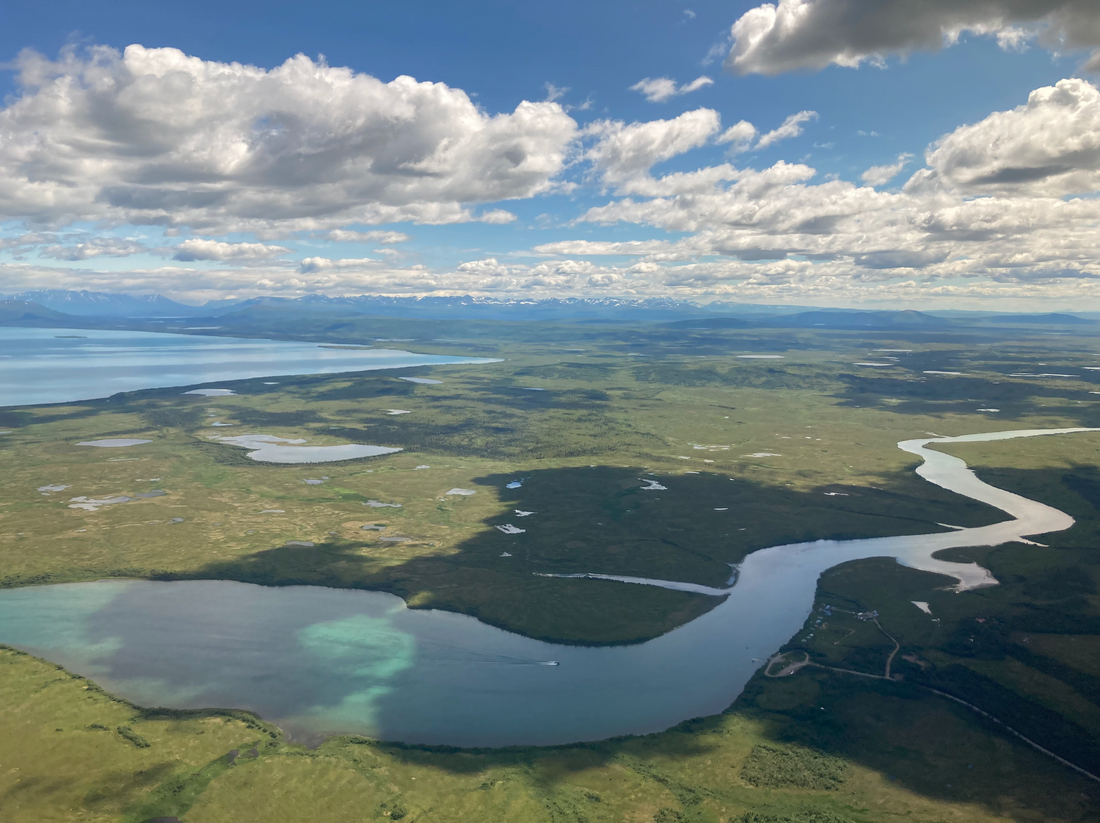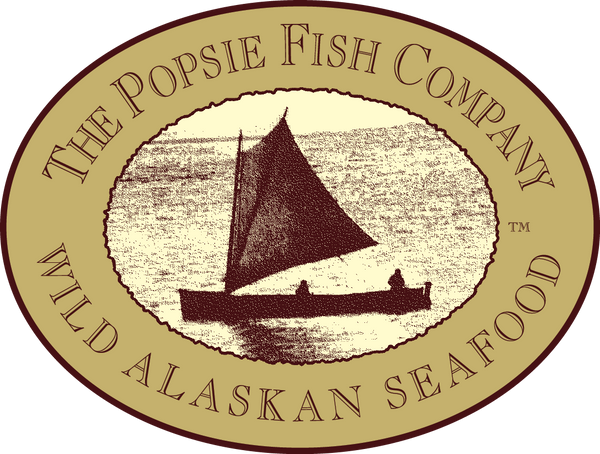
The Treasure of Bristol Bay Salmon
An eagle glides on sea breezes over the meandering estuaries of Bristol Bay. Far below, shore waters roil as masses of dorsal fins split the waters as far as the eagle’s eye can see. It’s the end of June, and the world’s most spectacular salmon migration has begun again.
It’s Bristol Bay, Alaska, off the Bering Sea, and salmon by the millions are returning to their home rivers, using their internal compasses and sense of smell to navigate the daunting distances to their natal streams.
Salmon has a long history in Alaska. The use of salmon on the coast of Alaska is dated to 7,000 years ago! Further, archeological evidence from the Proceedings of the National Academy of Sciences, has show an intimate tie between salmon and Alaska Native cultures for at least 11,500 years. Salmon bones were discovered in the hearth of the Upward Sun River site - the same place where the oldest human remains in North American Arctic were found. Although this is the oldest evidence of a connection between salmon and Alaska Natives, scientists believe the relationship could go as far back as 14,000 years ago.(1)
Camping along fertile shores and banks exploding with life in the summer months, family based groups would migrate from their winter hunting grounds using a mix of the arrival of seasonal animals and weather as their guides. Still present in many Alaska Native cultures, humans and animals are viewed as equals. Because of this, they believe salmon must be respected, or else they will not return to provide food to their communities (2).
We know from stories passed down over the generations that willow bark and rawhide nets were widely used in western Alaska, and that women and children often fished with setnets. These long nets, meticulously constructed, were dragged out perpendicular to the shore, like walls. They were anchored in the mud by weights - like rocks, and floated by whatever buoyancy device could be devised (sticks, kelp bulbs, animal bladders).
As the enormous migrations of salmon instinctively headed for the rivers emptying into the Bay, thousands of mature salmon would swim into those intricate nets and get caught by their gills. As each tide receded, families would wade into the waters, picking fish from the nets and tossing them into small rafts or baskets.

Their work had just begun. To preserve this essential protein and fat for the long winter ahead, families cut and cured their fish in smokehouses, hanging the gutted salmon above the fires by their tails in two long connected strips. All along the shores of western Alaska today, you’ll see fish being dried and smoked by the hundreds, continuing the tradition of families and small communities working together, sharing, laughing, and giving thanks for the life-giving salmon.
Fishing was a community affair until the late 1880’s, when Alaska became a U.S. territory. Then the canning industry began, with great infusions of money, supplies, and laborers from entrepreneurs in San Francisco, Portland, and Seattle involved in similar ventures in the Pacific Northwest (3). The first cannery in Bristol Bay was opened in 1883, and by 1910, the Bay accounted for 40% of Alaska's commercially caught salmon (4 & 5). By the early 1900s, dozens of canneries were catching and processing millions of pounds annually of salmon in Bristol Bay, using double-ender sailboats shipped from Columbia River fisheries (5). These iconic, sturdy boats required rugged fishermen who dealt with inclement weather and demanding bosses.

We may tend to romanticize that fifty-year-long era, but fishing in those open sailboats for six days at a time was cold and dangerous work. Fighting enormous tides, huge waves, wild winds and ever-shifting sand bars, fishermen needed excellent sailing skills, strong backs and a thirst for a living wage. On sunny days though, with only a light wind rippling their sails, those sleek boats brimming with glistening salmon were a beautiful sight and a delight to sail.
For years, motor boats were illegal in Bristol Bay for convoluted commercial reasons (a story in itself), and consequently, the era of picturesque sailboats lasted far longer than practical. But sailboats were hazardous, inefficient and increasingly outdated after World War II. The war drafted many non-resident fishermen, which lead to a breakthrough for local Alaskans to gain employment in the fishing industry. As World War II ended and veterans returned to Bristol Bay, they were not willing to risk the dangers of fishing in double-enders seen in 1948 on "The Bloody Fifth of July". Thus, in 1951, Congress passed a law allowing motorized fishing vessels in the Bay. Motors quickly replaced sails, and those sleek silent days soon slipped into the past. (5)

But still, they are remembered as one more chapter in Bristol Bay’s evolution. To commemorate the 70th anniversary of the end of the sailboat era in commercial fisheries, a fully restored Bristol Bay double-ender, with a crew of five, sailed 300 blustery miles from Homer to Naknek (including an overland portage). They left Homer on July 5, 2022 and arrived in Naknek on July 17th, 2022. That historic journey coincided with the most massive salmon run in Bristol Bay’s recorded history. (6)
Because of excellent science-based salmon management by the Alaska Department of Fish and Game, strong support by fishers and residents, and a potentially an increase in water temperature, numbers for the total catch and escapement (the number of fish returning to their home rivers and completing their life cycle) in Bristol Bay from 2022 were the highest ever: an estimated seventy-nine million fish! This run was 81% larger than the past 20 year average. (7)

Blessed by nature’s resiliency and by cooperation among scientists, government, and citizens, Bristol Bay enjoys a wildly sustainable fishery. After disastrous returns in the 70’s, state and federal agencies, along with individuals and corporations, cooperatively turned the tide and participated in the epic renewal of this vital keystone species.
The great, fractal estuaries would not be teeming with life without the migration, spawning and death of the sockeye salmon in this protected, intact environment. As tiny eggs and baby fry, the salmon hatchlings provide food for a myriad of predators. But those that survive all the perils, growing strong in the ocean, eventually return to the streams in which they hatched to reproduce so the cycle can continue. Their decaying bodies are their final gift to the environment, providing nutrients that fertilize the rivers, lakes and forest, enriching the entire watershed.
Rarely in today’s world does an ecosystem produce such bounty and maintain such a precious balance. Alaska’s salmon fishery is the pinnacle of sustainability, and the pride of the state and the nation.

This treasure of Bristol Bay, with its direct line to the past, needs continued respect and protection. Though challenges are inevitable - warming waters and resource extraction-for-profit efforts are constant looming threats - for now we can be grateful for this abundant, well-managed fishery. It allows valuable traditions to continue: wild salmon thriving in pristine environments, Alaska Native sustenance fishing, financial support to fishers and their families, and of course, the wild Sockeye salmon we catch for you. From the Fisher to the Fork.
Sources:
(2) https://www.adfg.alaska.gov/static/home/library/pdfs/ak_wild_salmon.pdf
(4) https://www.visitbristolbay.com/visitor-guide/cultures.html
(5) https://nncanneryproject.com/mugup-media/2018/3/18/when-sailboats-ruled-bristol-bay
(7) https://www.adfg.alaska.gov/static/applications/dcfnewsrelease/1438246231.pdf
